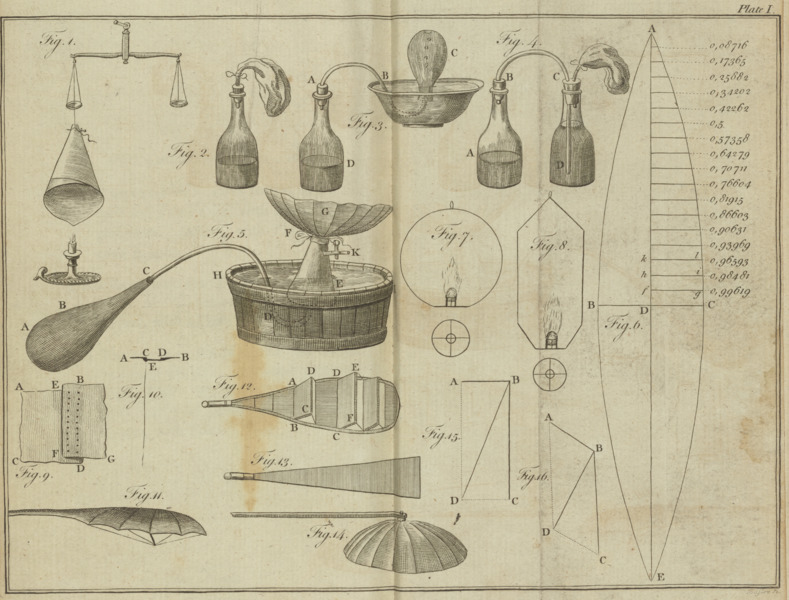Image: History and Practice of Aerostation plate i hh63sw95g 0 ms35t986sf

Description: Plate I: Illustrating the chemical apparatus and balloons used for hydrogen generation from The History and Practice of Aerostation Copperplate engraving illustrates the chemical apparatus and balloons used for hydrogen generation. Fig. 1: Practical experiment to show the principle behind a rarified (hot) air balloon. A paper cone is suspended from a balance, counterweighted with a small number of grains. A candle held beneath the paper cone will produce hot air trapped within the paper cone, causing that side of the balance to rise. Fig. 2: Practical experiment to show the principle behind an inflammable air (hydrogen) balloon. A bladder is affixed to one end of a glass tube; its other end is placed tightly through a cork in the neck of a bottle. Iron, water, and oil of vitriol (sulfuric acid) are placed in the bottle, producing hydrogen gas, which then fills the bladder above. Fig. 3: Creating and passing inflammable air (hydrogen) though water to fill a glass container. Fig. 4: Creating and passing inflammable air (hydrogen) through water to fill a bladder. Fig. 5: Contraption to heat materials to produce inflammable air to fill a balloon. A substance in an earthen or iron vessel (AB) is heated; gas is pushed along a brass tube (CD), through water in a barrel (HI), and eventually into a balloon (G). Cavallo notes that, when heated, various relatively cheap materials (e.g., pit-coal, asphaltum (bitumen), amber, rock oil, camphor, oil, spirits of wine (ethanol), etc.) can produce a gas that can be used for aerostatic experiments; this gas, however, is heavier than that produced using acids and metals, which is a more expensive method. Fig. 6: Pattern for one of many "slices" to be stitched together to make a balloon. Fig. 7: Cross-section of a paper balloon with plan of wire hoop and aperture frame below. Fig. 8: Cross-section of a paper balloon with plan of wire hoop and aperture frame below. Fig. 9: Best method of stitching sections of a balloon. Pieces are overlapped by about half an inch and double stitched. Fig. 10: Valve at the top of an inflammable air balloon. A leather-covered brass plate (AB) with a hole (CD) in its middle is fitted on the inside of the balloon with a spring-loaded, leather-covered flap valve. A cord attached to the valve runs through the center of the balloon down to the passenger boat, allowing the valve to be pulled open for whatever length of time necessary. Fig. 11: Wings used by Mr. Blanchard to direct the trajectory of an air balloon. Fig. 12: Wings used by Mr. Lunardi to direct the trajectory of an air balloon. Fig. 13: Wings used by Count Zambeccari to direct the trajectory of an air balloon. Fig. 14: Wings used by the Roberts brothers to direct the trajectory of an air balloon. Used in an aerial voyage on September 19, 1784. Fig. 15: Schematic of trajectory of air balloon under force of human power and wind power. A balloon which could be made to move from B to A with the use of wings, and which would otherwise move from B to C by force of wind power, will move from B to D under the combined force of wings and wind. Fig. 16: Schematic of trajectory of air balloon under force of human power and wind power. A balloon which could be made to move from B to A with the use of wings, and which would otherwise move from B to C by force of wind power, will move from B to D under the combined force of wings and wind. This volume by Tiberius Cavallo is considered one of the earliest and best works on aerostation published in eighteenth century England. Divided into two parts, this work details the history of aerostatics followed by its practice. The first part aims to record the most useful particulars of recent experiments in balloon flight. The second aims to convey the general principles of the subject to a broad readership. Accordingly, Cavallo used familiar expressions over technical terms and intentionally omitted mathematical demonstrations, considering them either obvious to mathematicians or unintelligible to anyone else. Cavallo's pioneering studies in aeronautics outlined within this work also includes how hydrogen is generated. Front cover, title page and copperplate engravings illustrating the chemical apparatus and balloons used for hydrogen generation are digitized within this work. Cavallo, Tiberius, 1749-1809. The history and practice of aerostation / by Tiberius Cavallo. London : Printed for the author and sold by C. Dilly, P. Elmsly, and J. Stockdale , 1785.
Title: Plate I: Illustrating the chemical apparatus and balloons used for hydrogen generation
Credit: https://digital.sciencehistory.org/works/pz50gx12x
Author: Cavallo, Tiberius, 1749-1809
Permission: This file was provided to Wikimedia Commons by the Science History Institute as part of a cooperation project.
Usage Terms: Public domain
License: Public domain
Attribution Required?: No
Image usage
The following page links to this image:

